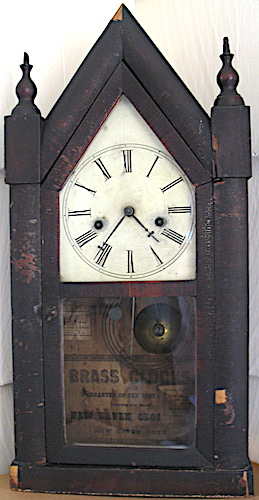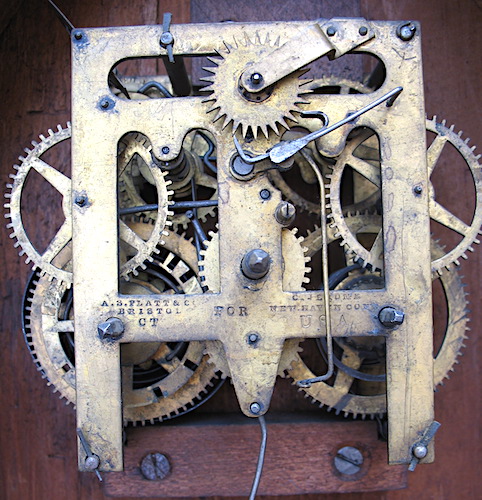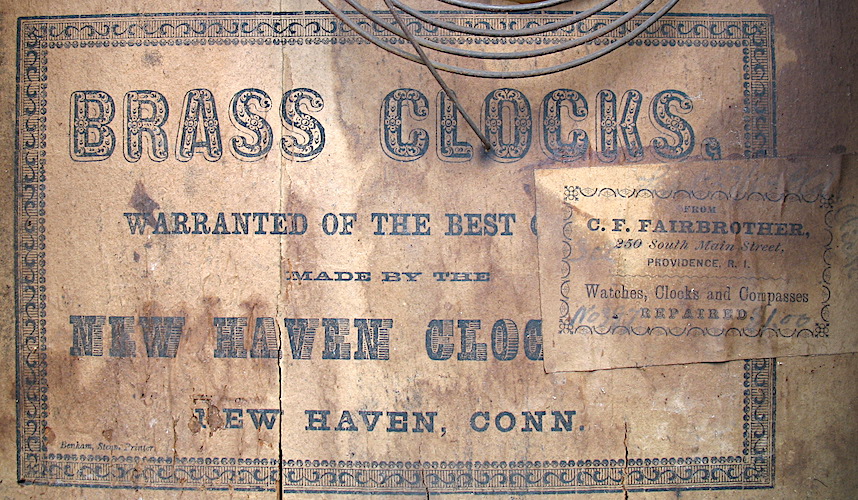New Haven Clock Co. sharp gothic (or steeple) clock possibly dating to the period right after the bankruptcy of the Jerome Manufacturing Co. and shortly after New Haven acquired the Jerome assets over the course of 1856-1857. The clock was found during an almost spur-of-the-moment stop at an antique store while vacationing in New Hampshire. When I opened the door of the clock (which almost fell off in my hands due to a missing hinge pin), I was surprised to see a New Haven label that I had never run across. The case was clearly in distress, with missing veneer, finials with busted tips, and a base (front piece) held on by Scotch tape. The finish is original and quite crusty. The dial, hands, and pendulum bob appear to be original.
Although I have some interest in New Haven’s early clocks, the condition of this one caused me to carefully close the door and walk away. But as I walked toward the front of the shop, I wondered what movement was in the clock. My assumption, based on the winding arbor positions, was that it was a type of 30-hr movement that New Haven used for decades (starting in the mid-1850s with ones made for Jerome) with very little modification. And my curiosity in the movement was more focused on whether it had a maker’s stamp. For a brief, but undefined, period, New Haven used a maker’s stamp that stated “NEW HAVEN/CLOCK CO. CT./U.S.A.”, and I suspected this clock might have that stamp. I asked the owner of the shop if it was okay for me to remove the dial and inspect the movement, and he said “go ahead”.
The movement, which I am certain is original, is stamped “A.S. PLATT & CO/BRISTOL/CT FOR C. JEROME/NEW HAVEN CONN/USA”. The movement and maker’s stamp were a major surprise. Both have been reported before on the NAWCC message board and in the NAWCC Bulletin. And Platt movements in Jerome clocks are not uncommon. See, for example, a 30-hr Jerome steeple and an 8-day Jerome steeple in my collection. The connections between AS Platt and Jerome were considerable, so much so that when Jerome went bankrupt in April of 1856, Platt followed in bankruptcy later that year, presumably due to payments never received from Jerome for Platt movements. When New Haven acquired the assets of the Jerome Manufacturing Co. it’s quite likely that Platt movements were in the inventory.
As I indicated above, I haven’t seen this particular New Haven label before, but that could simply be for want of looking. However, many of the early New Haven labels from the mid-1850s are very similar to ones used by Jerome earlier in the 1850s. Those serve both to advertise their product line as well as to offer directions on operating the clock. This label, on the other hand, is quite simple. Another thing to note is the printer’s line: “Benham, Steam Printer”. As early as 1849 and continuing into the 1860s, most of J(ohn) H(all) Benham’s listings and advertisements in the New Haven City Directory (which were printed by Benham) mentioned “steam printer”, referring to the use of steam to power his presses. Benham claimed that he was the first to introduce this method of powering printing presses in New Haven.
Another wonderful curiosity about the clock is the presence of a verse on the back side of the door that states:
“It is a shocking thing (to?) say
I’ll ever honor and obey;
They should, I think, reverse the plan,
And leave obedience to the man”
I haven’t been able to discover the source of this verse, but it appears to be an early expression of feminism. There’s clearly an objection to the wife’s duty to “honor and obey”.
How to explain a Platt-for-Jerome movement in a New Haven-labeled case? One explanation is that the entire steeple clock, with its Platt movement, was in production and nearly complete when the Jerome Manufacturing Co. failed. All New Haven had to do to get clocks like this on the market (and start getting a return on their investment) was get a run of labels printed. Equally plausible is that the Platt was a loose movement acquired during the bankruptcy that New Haven then cased. Perhaps favoring this scenario is the fact that the label appears to extend behind the sides of the clock, suggesting that the label was glued on before the backboard was nailed to the case. Regardless, the movement and label directly tie the clock to a period when not only Jerome, but also Platt, went bankrupt, and the former Jerome factory was given new life under New Haven ownership.




